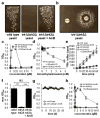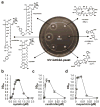Restored Physiology in Protein-Deficient Yeast by a Small Molecule Channel
- PMID: 26230309
- PMCID: PMC4691626
- DOI: 10.1021/jacs.5b05765
Restored Physiology in Protein-Deficient Yeast by a Small Molecule Channel
Abstract
Deficiencies of protein ion channels underlie many currently incurable human diseases. Robust networks of pumps and channels are usually responsible for the directional movement of specific ions in organisms ranging from microbes to humans. We thus questioned whether minimally selective small molecule mimics of missing protein channels might be capable of collaborating with the corresponding protein ion pumps to restore physiology. Here we report vigorous and sustainable restoration of yeast cell growth by replacing missing protein ion transporters with imperfect small molecule mimics. We further provide evidence that this tolerance for imperfect mimicry is attributable to collaboration between the channel-forming small molecule and protein ion pumps. These results illuminate a mechanistic framework for pursuing small molecule replacements for deficient protein ion channels that underlie a range of challenging human diseases.
Conflict of interest statement
The authors declare no competing financial interests.
Figures




References
-
- Hubner CA, Jentsch TJ. Hum Mol Gen. 2002;11:2435. - PubMed
-
- Rouleau G. Ion Channel Diseases. Elsevier; Amsterdam: 2008.
-
- Ermishkin LN, Kasumov KM, Potzeluyev VM. Nature. 1976;262:698. - PubMed
-
- El-Etri M, Cuppoletti J. Am J Physiol. 1996;270:L386. - PubMed
-
- Busschaert N, Gale PA. Angew Chem Int Ed Engl. 2013;52:1374. - PubMed
Publication types
MeSH terms
Substances
Grants and funding
LinkOut - more resources
Full Text Sources
Other Literature Sources
Molecular Biology Databases

